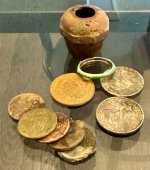hondachopper
Tenderfoot
I saw this and thought you all may be interested. this man has started unearthing an old nazi bunker in his yard, no "nazi gold" but still a neat find, but he is updating this blog regularly. it's definitely an interesting read, the link goes to the introduction page. . .
http://gardenbunker.blogspot.com/2008/06/background.html
http://gardenbunker.blogspot.com/2008/06/background.html




